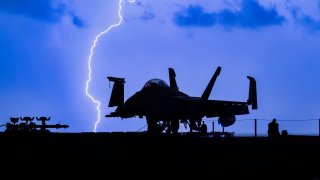U.S. Navy Aircraft Carrier USS Theodore Roosevelt Has Just 1 Mission
The USS Theodore Roosevelt (CVN-71) was launched in 1984 and commissioned in 1986. President Ford initially canceled its construction, but it was later authorized due to the Iran hostage crisis.
Summary: The USS Theodore Roosevelt (CVN-71) was launched in 1984 and commissioned in 1986. Initially canceled by President Ford, its construction was later authorized due to the Iran hostage crisis.
Aircraft Carrier: USS Theodore Roosevelt (CVN-71) - Key Facts
-The carrier has played key roles in Operation Desert Storm, Provide Comfort, Deny Flight, Southern Watch, and Enduring Freedom.
-Known for its significant combat contributions and extended deployments, CVN-71 is one of the most decorated post-Cold War warships.
-Now modernized, it continues to be a formidable presence in the U.S. Navy.
USS Theodore Roosevelt: A Legacy of Power and Resilience
The USS Theodore Roosevelt has a straightforward goal: use its air wing to crush any U.S. enemy, anywhere on the planet.
Construction of CVN-71 began more than four decades ago, and the carrier was launched in October 1984 and commissioned two years later in October 1986. USS Theodore Roosevelt began her maiden deployment in late December 1988 with Carrier Air Wing Eight (CVW-8) embarked.
However, it almost never happened. President Gerald Ford had actually cancelled the order for CVN-71 in 1976 and instead sought to build two conventional-powered carriers that could operate with vertical and/or short takeoff and landing aircraft.
President Jimmy Carter also initially opposed the building of the nuclear-powered carrier, but he reversed course following the Iran hostage crisis, which highlighted the need for U.S. carrier battle groups to remote regions of the world. Construction of CVN-71 was finally authorized under the Fiscal Year 1980 (FY80) authorization bill for the Department of Defense (DoD).
Theodore Roosevelt Goes to War
While named for the man who remarked it was wise to speak softly and carry a big stick, Roosevelt was still one who didn't shy away from doing his part. So it was somewhat fitting that just over two years after entering service, Theodore Roosevelt was deployed to take part in Operation Desert Shield and arrived in the Persian Gulf in mid-January 1991.
During the subsequent Operation Desert Storm, which actually began the day before the carrier arrived on station, the vessel took part in combat operations where pilots flew more than 4,200 sorties – more than any other carrier. In total, aircraft operating from Theodore Roosevelt dropped more than 4.8 million pounds of ordnance.
The warship's airwing later took part in patrols during Operation Provide Comfort to support Kurdish forces in Iraq, and then a year later in Operation Deny Flight to support the U.S. no-fly zone over Bosnia. CVN-71 then became one of only a few nuclear-powered warships to transit the Suez Canal when she was deployed to participate in Operation Southern Watch over Iraq.
Theodore Roosevelt began her seventh deployment just after the September 11, 2001 terrorist attacks on New York City and the Pentagon, and joined the already-present USS Enterprise and USS Carl Vinson and conducted attacks against al-Qaeda forces in Afghanistan during Operation Enduring Freedom. While deployed in the region, Theodore Roosevelt spent a total of 160 consecutive days at sea, and broke the record for the longest period underway of a U.S. carrier since World War II.
The carrier is also one of the most decorated warships of the post-Cold War era. Her awards include a Joint Meritorious Unit Award, three Navy Unit Commendations, five Battle Efficiency Awards (Battle "E"), two National Defense Service Medals, two Security Excellence Awards, and a Global War on Terrorism Expeditionary Medal among others. The warship also was awarded a NATO Medal as well as Kuwait Liberation Medals from both Kuwait and Saudi Arabia.
The warship is now sailing again – and she is now an ever-more capable vessel.
Author Experience and Expertise: Peter Suciu
Peter Suciu is a Michigan-based writer. He has contributed to more than four dozen magazines, newspapers, and websites with over 3,200 published pieces over a twenty-year career in journalism. He regularly writes about military hardware, firearms history, cybersecurity, politics, and international affairs. Peter is also a Contributing Writer for Forbes and Clearance Jobs. You can follow him on Twitter: @PeterSuciu. You can email the author: [email protected].
All images are Creative Commons.


